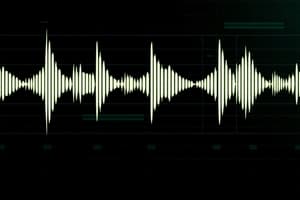Podcast
Questions and Answers
What is envelope detection in AM?
What is envelope detection in AM?
Detecting the amplitude of the signal at any given time.
Describe synchronous demodulation in AM.
Describe synchronous demodulation in AM.
Multiplying the received AM signal with a synchronized carrier wave and filtering the result.
What is Double Sideband Amplitude Modulation (DSB-AM)?
What is Double Sideband Amplitude Modulation (DSB-AM)?
AM classification where both upper and lower sidebands are transmitted.
What is Single Sideband Amplitude Modulation (SSB-AM)?
What is Single Sideband Amplitude Modulation (SSB-AM)?
Name an advantage of Amplitude Modulation.
Name an advantage of Amplitude Modulation.
What is a practical application of Amplitude Modulation?
What is a practical application of Amplitude Modulation?
What is Amplitude Modulation (AM)?
What is Amplitude Modulation (AM)?
What is the purpose of the carrier wave in AM?
What is the purpose of the carrier wave in AM?
What is the modulating signal in AM?
What is the modulating signal in AM?
Explain the Amplitude Modulation (AM) process using an analogy with sound waves.
Explain the Amplitude Modulation (AM) process using an analogy with sound waves.
What is AM demodulation?
What is AM demodulation?
Name two primary methods for demodulating AM signals.
Name two primary methods for demodulating AM signals.
Flashcards are hidden until you start studying
Study Notes
Amplitude Modulation (AM)
Amplitude Modulation (AM) is a fundamental technique in radio communication that's been around since the early 20th century. This method allows us to convert a modulating signal, such as speech, music, or data, into a carrier wave suitable for radio transmission. In AM, the amplitude of the carrier wave is varied in accordance with the modulating signal, thus imparting information onto the carrier.
Carrier Wave
The carrier wave is an electromagnetic wave with a fixed frequency, which is used as a basis for transmitting information over the airwaves. The carrier wave is essential for AM and is often a high-frequency radio wave.
Modulating Signal
The modulating signal contains the information we want to transmit. AM alters the amplitude of the carrier wave in accordance with the modulating signal.
Amplitude Modulation (AM) Process
To understand AM, let's consider an analogy with sound waves. Imagine a loudspeaker playing a steady tone. If we vary the speaker's volume in accordance with an input signal, we're essentially amplitude modulating the carrier tone. On the radio, this is similar to a carrier wave that periodically increases and decreases in amplitude based on the modulating signal.
Demodulation
AM demodulation is the process of extracting the original modulating signal from the modulated carrier wave. There are two primary methods for demodulating AM signals: envelope detection and synchronous demodulation. Envelope detection involves detecting the amplitude of the signal at any given time. Synchronous demodulation, on the other hand, involves multiplying the received AM signal with a synchronized carrier wave and then filtering the result to recover the modulating signal.
Double Sideband Amplitude Modulation (DSB-AM)
Double Sideband Amplitude Modulation (DSB-AM) is a common classification of AM where both the upper and lower sidebands of the modulated signal are transmitted. This type of AM is more efficient for transmitting audio signals, but it does result in more bandwidth usage than single sideband AM (SSB-AM).
Single Sideband Amplitude Modulation (SSB-AM)
In Single Sideband Amplitude Modulation (SSB-AM), only one sideband (either the upper or lower) is transmitted. This results in a more efficient use of frequency bandwidth but can be more difficult to implement. In practice, SSB-AM is often used in conjunction with phase modulation (PM) to maintain the original signal's phase information.
Advantages and Disadvantages
Amplitude Modulation has several advantages, such as being relatively easy to implement, having good noise immunity, and being compatible with a wide range of modulating signals. However, AM is less efficient than other modulation schemes, such as frequency modulation (FM), and it suffers from several forms of interference.
Applications of AM
Amplitude Modulation has several practical applications, such as medium wave radio broadcasting, amateur radio, and shortwave radio. AM has been a staple of radio communication for nearly a century and continues to serve as a reliable and relatively straightforward method of transmitting information over the airwaves.
In summary, amplitude modulation is a foundational technique in radio communication that enables modulating signals to be transmitted via a carrier wave with its amplitude varying in accordance with the modulating signal. This modulation enables us to recover the original information from the transmitted signal.
Studying That Suits You
Use AI to generate personalized quizzes and flashcards to suit your learning preferences.




